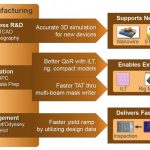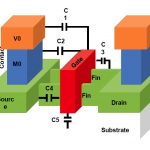In an overwhelmingly digital world, there is a constant cry about the analog design process being slow, not automated, going at its own pace in the same old fashion, and so on. And, the analog world is not happy with the way it’s getting dragged into imperfect automation so it can be more like the digital world. True, the analog world… Read More
Samsung: the Journey to 14nm and 10nm
At the Samsung theatre (cutely named the Samsung Open Collaboration (SoC) theater) I watched a presentation by KK Lin on using DFM to bring up their 14nm and 10nm processes. And yes, they are real. Here is a picture I took of a 14nm wafer and a 10nm wafer. Samsung announced that they would ramp 10n to volume production by the end of next… Read More
TSMC Shows 10nm Wafer!
If you really want to know why I write about TSMC it is all about ego, my massive ego, absolutely. Blogs about TSMC and the foundries have always driven the most traffic and they most likely always will. Semiconductor IP is second, Semiconductor Design is third, and I don’t think that is going to change anytime soon:
SemiWiki BI: Daniel… Read More
Samsung Foundry Debuts 10nm Wafer!
The Samsung Smart, Connected Lifestyle event was last night at the Bently Reserve in San Francisco. Getting into San Francisco was no picnic with all of the roadwork and new building construction. We even saw people drive up on the sidewalk to get around car clogs. It really was crazy but definitely worth it after seeing the first … Read More
TCAD Enables Moore’s Law to Continue
We live in very interesting times, you can wear an Android watch from Samsung that uses 14 nm FinFET technology, attend the 52nd DAC conference in June to learn about EDA and IP vendors supporting FinFET, and read about research work for new devices down to 5 nm. TCAD is that critical software technology that enables the development… Read More
TSMC 10nm Readiness and 3DIC
At the TSMC Technology Symposium last month Suk Lee presented a lot of information on design enablement. Suk is an interesting guy with a unique background in ASIC, Semiconductor, EDA, and now Foundry. In baseball terms that would be like playing infield, outfield, home plate, and umpire!
Around the turn of the millennium Suk actually… Read More
Motley Fooled by FinFETs!
There was an article on Motley Fool recently detailing Intel’s 14nm FinFETs and comparing them to TSMC. Unfortunately the author has zero semiconductor education or experience even though he writes with authority on all things semiconductor. He also has no shame in using outdated papers from conferences he did not even… Read More
FinFET vs FDSOI – Which is the Right One for Your Design?
As a professional conference goer I can see definite trends when it comes to topics and attendance. Thus far this year I have seen a double digit increase in attendance, which is great. The question is why? Why is the fabless semiconductor ecosystem leaving the safety of their cubicles and computer screens in droves to mingle amongst… Read More
FinFET Design Enablement
We read about FinFET technology in the semiconductor press daily now, thanks to Intel introducing their TriGate transistors starting in 2011 and creating a race with foundries and IDMs to switch from planar CMOS nodes. To get some perspective about the progress of FinFET IP and EDA tools I spoke with two experts from Synopsys, Swami… Read More
2015, the Year of the Sheep…And the 16nm FPGA
If you live in California anyway, with its large Asian population, you can’t have helped noticing that it was the Lunar New Year a couple of weeks ago, the start of the year of the sheep. A couple of days after the New Year, Xilinx announced their new families of what they now call FPGAs, 3D ICs and MPSoCs. But which the rest of us … Read More





Website Developers May Have Most to Fear From AI